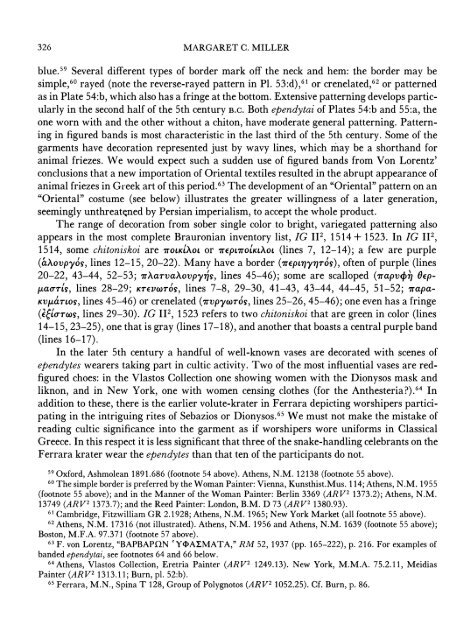the ependytes in classical athens - The American School of ...
the ependytes in classical athens - The American School of ...
the ependytes in classical athens - The American School of ...
Create successful ePaper yourself
Turn your PDF publications into a flip-book with our unique Google optimized e-Paper software.
326 MARGARET C. MILLER<br />
blue.59 Several different types <strong>of</strong> border mark <strong>of</strong>f <strong>the</strong> neck and hem: <strong>the</strong> border may be<br />
simple,60 rayed (note <strong>the</strong> reverse-rayed pattern <strong>in</strong> P1. 53:d),61 or crenelated,62 or patterned<br />
as <strong>in</strong> Plate 54:b, which also has a fr<strong>in</strong>ge at <strong>the</strong> bottom. Extensive pattern<strong>in</strong>g develops particularly<br />
<strong>in</strong> <strong>the</strong> second half <strong>of</strong> <strong>the</strong> 5th century B.C. Both ependytai <strong>of</strong> Plates 54:b and 55:a, <strong>the</strong><br />
one worn with and <strong>the</strong> o<strong>the</strong>r without a chiton, have moderate general pattern<strong>in</strong>g. Pattern<strong>in</strong>g<br />
<strong>in</strong> figured bands is most characteristic <strong>in</strong> <strong>the</strong> last third <strong>of</strong> <strong>the</strong> 5th century. Some <strong>of</strong> <strong>the</strong><br />
garments have decoration represented just by wavy l<strong>in</strong>es, which may be a shorthand for<br />
animal friezes. We would expect such a sudden use <strong>of</strong> figured bands from Von Lorentz'<br />
conclusions that a new importation <strong>of</strong> Oriental textiles resulted <strong>in</strong> <strong>the</strong> abrupt appearance <strong>of</strong><br />
animal friezes <strong>in</strong> Gireek art <strong>of</strong> this period.63 <strong>The</strong> development <strong>of</strong> an "Oriental" pattern on an<br />
"Oriental" costume (see below) illustrates <strong>the</strong> greater will<strong>in</strong>gness <strong>of</strong> a later generation,<br />
seem<strong>in</strong>gly unthreatqned by Persian imperialism, to accept <strong>the</strong> whole product.<br />
<strong>The</strong> range <strong>of</strong> decoration from sober s<strong>in</strong>gle color to bright, variegated pattern<strong>in</strong>g also<br />
appears <strong>in</strong> <strong>the</strong> most complete Brauronian <strong>in</strong>ventory list, IG 112, 1514 + 1523. In IG 112,<br />
1514, some chitoniskoi are roLKtXot or 7EpL7TOLKLtot (l<strong>in</strong>es 7, 12-14); a few are purple<br />
(a;Xovpy0s-, l<strong>in</strong>es 12-15, 20-22). Many have a border ('7rEptLqyqjro), <strong>of</strong>ten <strong>of</strong> purple (l<strong>in</strong>es<br />
20-22, 43-44, 52-53; 'rkarva?ovpyr's-, l<strong>in</strong>es 45-46); some are scalloped ('rapv4' Gep-<br />
iao-rts-, l<strong>in</strong>es 28-29; KTEvcro's-, l<strong>in</strong>es 7-8, 29-30, 41-43, 43-44, 44-45, 51-52; 7rapa-<br />
KVcLartos-, l<strong>in</strong>es 45-46) or crenelated ('rvpywr's-, l<strong>in</strong>es 25-26, 45-46); one even has a fr<strong>in</strong>ge<br />
(kiorcos-, l<strong>in</strong>es 29-30). IG 112, 1523 refers to two chitoniskoi that are green <strong>in</strong> color (l<strong>in</strong>es<br />
14-15, 23-25), one that is gray (l<strong>in</strong>es 17-18), and ano<strong>the</strong>r that boasts a central purple band<br />
(l<strong>in</strong>es 16-17).<br />
In <strong>the</strong> later 5th century a handful <strong>of</strong> well-known vases are decorated with scenes <strong>of</strong><br />
<strong>ependytes</strong> wearers tak<strong>in</strong>g part <strong>in</strong> cultic activity. Two <strong>of</strong> <strong>the</strong> most <strong>in</strong>fluential vases are redfigured<br />
choes: <strong>in</strong> <strong>the</strong> Vlastos Collection one show<strong>in</strong>g women with <strong>the</strong> Dionysos mask and<br />
liknon, and <strong>in</strong> New York, one with women cens<strong>in</strong>g clo<strong>the</strong>s (for <strong>the</strong> An<strong>the</strong>steria?).64 In<br />
addition to <strong>the</strong>se, <strong>the</strong>re is <strong>the</strong> earlier volute-krater <strong>in</strong> Ferrara depict<strong>in</strong>g worshipers participat<strong>in</strong>g<br />
<strong>in</strong> <strong>the</strong> <strong>in</strong>trigu<strong>in</strong>g rites <strong>of</strong> Sebazios or Dionysos.65 We must not make <strong>the</strong> mistake <strong>of</strong><br />
read<strong>in</strong>g cultic significance <strong>in</strong>to <strong>the</strong> garment as if worshipers wore uniforms <strong>in</strong> Classical<br />
Greece. In this respect it is less significant that three <strong>of</strong> <strong>the</strong> snake-handl<strong>in</strong>g celebrants on <strong>the</strong><br />
Ferrara krater wear <strong>the</strong> <strong>ependytes</strong> than that ten <strong>of</strong> <strong>the</strong> participants do not.<br />
59 Oxford, Ashmolean 1891.686 (footnote 54 above). A<strong>the</strong>ns, N.M. 12138 (footnote 55 above).<br />
60 <strong>The</strong> simple border is preferred by <strong>the</strong> Woman Pa<strong>in</strong>ter: Vienna, Kunsthist.Mus. 114; A<strong>the</strong>ns, N.M. 1955<br />
(footnote 55 above); and <strong>in</strong> <strong>the</strong> Manner <strong>of</strong> <strong>the</strong> Woman Pa<strong>in</strong>ter: Berl<strong>in</strong> 3369 (AR V2 1373.2); A<strong>the</strong>ns, N.M.<br />
13749 (AR V2 1373.7); and <strong>the</strong> Reed Pa<strong>in</strong>ter: London, B.M. D 73 (AR V2 1380.93).<br />
61 Cambridge, Fitzwilliam GR 2.1928; A<strong>the</strong>ns, N.M. 1965; New York Market (all footnote 55 above).<br />
62 A<strong>the</strong>ns, N.M. 17316 (not illustrated). A<strong>the</strong>ns, N.M. 1956 and A<strong>the</strong>ns, N.M. 1639 (footnote 55 above);<br />
Boston, M.F.A. 97.371 (footnote 57 above).<br />
63 F. von Lorentz, "BAPBAP?QN 'Y?AZMATA," RM 52, 1937 (pp. 165-222), p. 216. For examples <strong>of</strong><br />
banded ependytai, see footnotes 64 and 66 below.<br />
64 A<strong>the</strong>ns, Vlastos Collection, Eretria Pa<strong>in</strong>ter (AR V2 1249.13). New York, M.M.A. 75.2.11, Meidias<br />
Pa<strong>in</strong>ter (AR V2 1313.1 1; Burn, pl. 52:b).<br />
65 Ferrara, M.N., Sp<strong>in</strong>a T 128, Group <strong>of</strong> Polygnotos (AR V2 1052.25). Cf. Burn, p. 86.

















